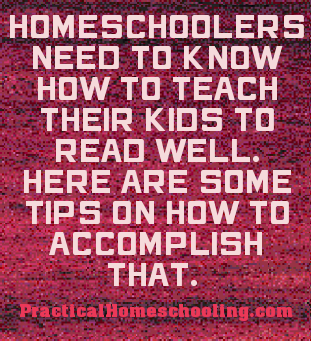How to Teach Reading & Measure Your Child's Reading Skills
By Michael Maloney
Printed in Practical Homeschooling #58, 2004.
 Homeschoolers need to know how to teach their kids to read well. Here are some tips on how to accomplish that.
Homeschoolers need to know how to teach their kids to read well. Here are some tips on how to accomplish that.

|
 |
 The single most important academic task facing homeschoolers is to teach the children to read well. Teaching reading effectively empowers children to learn much more on their own. Failure to do so means that everything else of an educational nature becomes a much harder slog for both parent and child. Children need to become fluent readers with the ability to decode words quickly and accurately at about the same rate at which they speak. That is fluent reading; anything less than that is not.
The single most important academic task facing homeschoolers is to teach the children to read well. Teaching reading effectively empowers children to learn much more on their own. Failure to do so means that everything else of an educational nature becomes a much harder slog for both parent and child. Children need to become fluent readers with the ability to decode words quickly and accurately at about the same rate at which they speak. That is fluent reading; anything less than that is not.
About 65 percent of all students will learn to read with little or no problem. They become fluent readers quite easily. They also tend to read more independently. Most often the remaining 35 percent of the children are labeled as having reading difficulties or even "learning disabilities."
Having helped to teach 10,000 children to read over the past 30 years, I suggest that "learning disabilities" stem largely from inadequate instruction and/or insufficient practice. Good teaching and carefully monitored practice can eradicate all but a very small proportion of these "learning disabilities."
Teaching Phonics
Teaching a child to read involves a number of critical tasks. First and foremost, the child has to learn the sound-symbol relationship. The child must be able to associate which sound goes with which symbol - a process we call "teaching phonics." Teaching phonics sounds easy enough and has been proven by thousands of research studies to be the most effective way to teach children to decode words. Teaching phonics gets harder when the same symbol has more than one possible sound. The child may be tempted to guess at which one this could possibly be in this particular word.
Teaching Blending Skills
The second major task is to teach children to blend the individual sounds together into words. Blending sounds into words works for the two-thirds of the words in the English language that are phonetically regular. The remaining one-third, which children cannot totally sound out, needs a different strategy.
Teaching Story Reading
The third and final major decoding task is to ensure that children learn to read sentences, passages, and entire books fluently. Initially they read aloud to someone who can correct their errors. Once we are assured that the child can read accurately and quickly we can convert to silent reading.
Setting Standards of Fluency
How do you know when each or any of these tasks have been done well enough that you can go on to the next lesson? How do you know that the child knows the material well enough that you can introduce new curriculum? Like all behaviors, each of these performances has a range of frequencies to indicate when success has been reached.
Fluent Phonics
Children should be able to look at a sound or a list of sounds that they have been taught and say each one without hesitation. Measuring that skill as a count-over-time measure yields a score of 50 to 60 sounds per minute. To determine an accuracy criterion, we consider no more than two errors per minute to be sufficient. Children also have to discriminate between short sounds like "d" and continuous sounds like "mmm." Children who do not hold the continuous sounds like "mmm" for a half second and treat all sounds as short sounds will have a much more difficult time blending sounds together later.
Children can say more than 100 sounds per minute if they are allowed to treat all sounds as short sounds. That is too fast and sets the stage for later blending problems.
Flash cards of the sounds already taught in the program are a good way to solve this problem. Put one sound or sound combination on each flash card. Put a dot (·) under each continuous sound or sound combination. Put a chevron (>) under each short sound. Teach the child to hold any sound that has a dot under it for a half second. Children can only flip about 50 flash cards per minute, which sets an automatic behavioral ceiling on the behavior.
Fluent Blending Skills
First we must sort the words into those, which are phonetically regular and can be sounded out from those, which are phonetically irregular and cannot be totally sounded out. Once again word lists or flash cards with one word per card of words already taught in the lessons are useful tools especially for phonetically regular words. Place dots under the continuous sounds in each word and chevrons under the short sounds. Teach the children to hold each sound that has a dot and to slide quickly past each chevron.
In the phonetically regular word set, children say the sounds for each word, holding each of the continuous sounds for a half second and then saying the word. They must be taught not to stop between the sounds, but to blend the sounds together without any breaks.
Given a mix of short sounds that can be said quickly and continuous sounds that need a half second each, there is a limit to the number of sounds a reader can say per unit of time. The mix of short and continuous sounds limits their production to about 100 sounds per minute.
Each flash card or word in the list can have a number beside it showing the number of sounds in that word. In sound combinations, a single sound will consist of two or more letters, so counting letters isn't an accurate enough measure. When the child can blend 80 to 100 sounds per minute with no more than two errors, they have mastered the blending skills for those words and are ready for new ones.
Fluent Word Reading
Once we know how to decode a word, it becomes a sight word. We simply look at it and say it. Until we know it, we need to sound it out if it is phonetically regular or use some other strategy if it is not. All words are sight words to fluent readers. Good readers can decode words as quickly as they can speak. Humans speak at 200 to 250 words per minute. When they can read passages fluently, they read them at that rate, almost as if they were speaking, not reading.
Some people like to graduate children to higher reading rates as they age. They hold primary school children to 125 words per minute on stories, junior and senior students to 200-250. It's a matter of personal choice.
Some Fluency Standards for Decoding
During the past 25 years with millions of measurements, Precision Teaching adherents have developed a number of fluency standards for the decoding aspects of reading. Fluency standards always indicate the pace of the behavior and the degree of accuracy required. We are not interested in developing fast, sloppy readers. The most commonly used fluencies for decoding aspects of reading are listed below.
- Saying alphabet in order 250-300 letters per minute, 0-2 errors.
- Saying alphabet in mixed order 100-120 per minute, 0-2 errors
- Saying sounds from a list 50-60 sounds per minute, 0-2 errors
- Sounding out phonetically regular words 10-12 words/minute, 0-2 errors
- Reading word lists 60-80 words per minute, 0-2 errors
- Oral reading of any story (primary grades) 100-125 words/min, 0-2 errors
- Oral reading of any story (grade 7 and up) 200-250 words/min, 0-2 errors
- Silent reading of any story 300-450 words per minute, 0-2 errors
- Technical reading (e.g. directions, instructions) 125-150/minute, 0-2 errors.
Timing Students
For lists of sounds, for alphabet in order or in mixed order and for lists of words, we almost always use a 30-second timing. We then double the scores to report corrects and errors on a count per minute basis. For passage reading, a one-minute timing works best. All scores are reported as count per minute.
When you want to do a 30-second or a one-minute measurement to determine fluency, do not start the timing with "Ready, Set, Go." This is not a race. We are simply gathering a sample of reading performance, like taking a pulse to measure heart rate. Use "Ready" to signal the task is about to begin. Say "Please Begin" to start and "Thank you" at the end of the time.
Other Tips
- Praise effort.
- Teach the student that the objective is to get one more word or one more sound than we did last time or to reduce errors by one or more.
- Allow the student to practice before you take the measurement.
- Take the best score of all attempts of any session.
- Watch for points at which the student hesitates. That's where the problem is.
- Make lists or flash cards of the words that are difficult for the student and practice them frequently.
- Let the student time you so that her or she can hear what fluent performances sound like.
- Practice at least 10 words beyond the student's best attempt so that those words become more familiar and easier to do next time.
- Record the data so that you can see and discuss the improvement with the child.